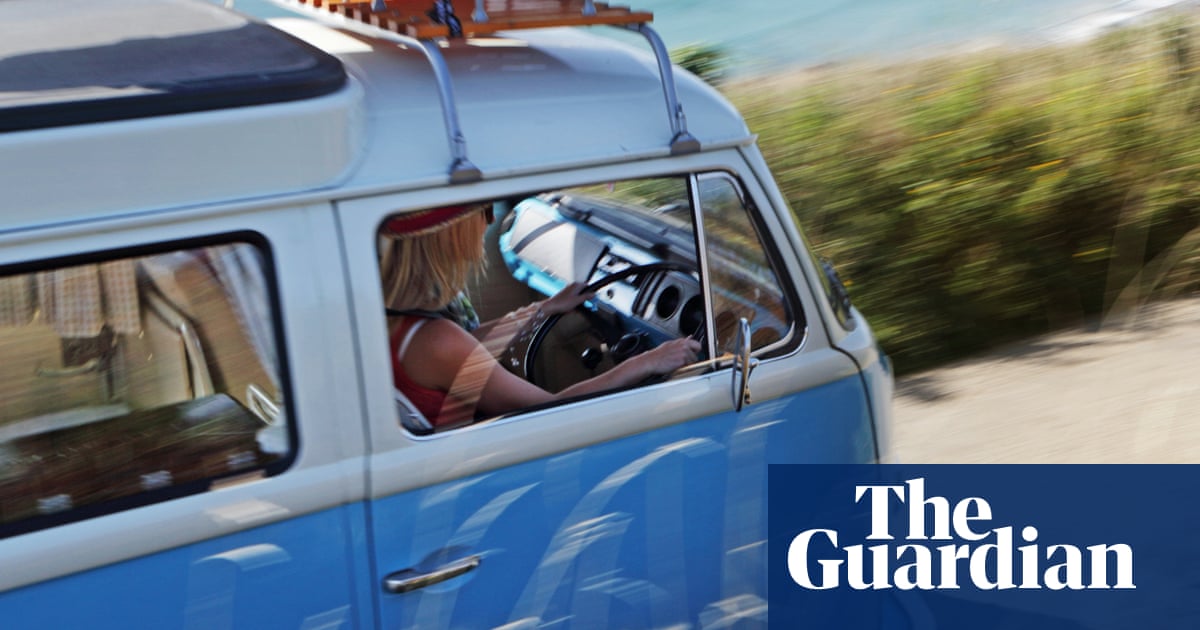The British coastline is a thriving marine habitat, with a biodiversity that’s driven by high tidal range and strong nutrient-rich currents. When conditions are right, snorkelling in British waters brings a connection with a variety of species and stunning terrain: sea lochs, sheltered bays, shipwrecks, tidal pools, kelp forests, sandy seabeds and rocky reefs. You might see sharks, seals, scorpionfish, octopus and cuttlefish. These are our 10 favourite spots.
Treyarnon tidal pool, Cornwall

Treyarnon, near Padstow, is a great place to combine a family day at the beach with a spot of rockpooling or snorkelling. The tidal pool here is large enough to snorkel around, but shallow enough that even the most wary can wade in confidently, don a mask or goggles, and peek at the wonders below the water’s surface. Particularly good for introducing kids to the underwater world, the pool is mostly natural, with a small concrete barrage complementing its otherwise watertight rocky walls. The beach can get very busy in the summer, but that popularity has its benefits – an ice-cream van is often parked at the top of the beach for post-snorkelling refreshments.
Chesil Cove, Dorset
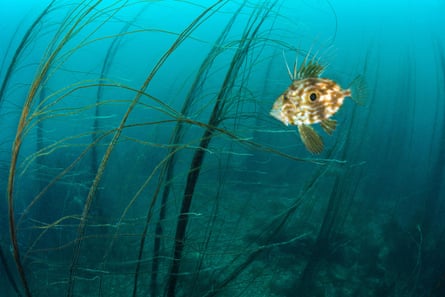
An 18-mile (29km) shingle tombolo formed by the accumulation of pebbles over 7,000 years, Chesil Beach is significantly exposed to stormy weather from the south and west. At its southernmost end is Chesil Cove. As with the rest of the coastline here, the cove’s exposed aspect results in variable visibility, oscillating between nil and fabulous depending on the weather. Pick the right day, however, and it’s a perfect place to snorkel. The best area to explore is at the far south of the cove, where uniform small pebbles give way to larger rocks and boulders covered in kelp and other seaweeds. Here, you’ll find sand eels, wrasse, bass and, on occasion, wonderfully prehistoric-looking john dory. Cephalopods such as cuttlefish and their less commonly seen cousins, squid and octopus, are also occasional visitors to the area; keep your eyes peeled for these masters of disguise.
Eastbourne pier, East Sussex
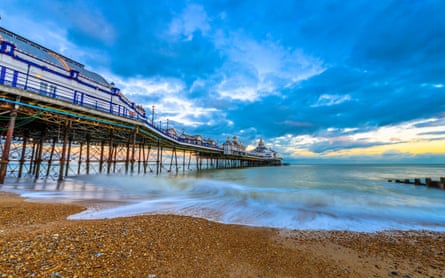
Originally built in the late 19th century, and restored after a fire in 2014, Eastbourne pier makes a pleasant focal point for a snorkel in calm weather. Shingle beaches along this stretch of the southeast coastline are relatively inhospitable: the churning action of the waves gives marine life little chance to establish itself on the pebbles. However, the pier pilings provide a more stable footing and are covered with barnacle-encrusted common mussels and patches of sea lettuce. In turn, the mussels attract predators such as starfish, crabs and dog whelks. The regular presence of fishers on the pier suggests this site also attracts its fair share of fish – so watch out for those lines! You may catch a fleeting glimpse of sand eels which, in turn, draw in larger fish such as bass. Swimming around the pier at sunset is an atmospheric way to end the day.
Boggle Hole, North Yorkshire
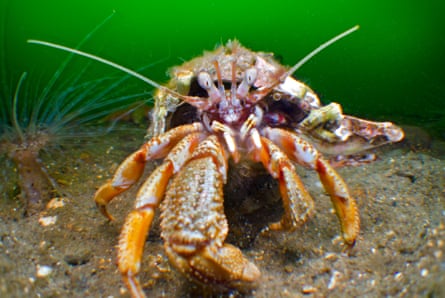
Geology and strong currents (particularly at high tide) mean snorkelling opportunities are few and far between on this stretch of coastline but, in calm conditions, after a spell of settled weather, Boggle Hole is an excellent spot. There is so much life to see, even in the shallows. The shoreline is laced with ledges of exposed rock that provide a fantastic habitat for smaller marine life such as blennies, gobies and smaller crabs. Larger boulders, meanwhile, are covered with a patchwork of molluscs, clinging on against the ebb and flow of the tides, plus vivid patches of purple algae, and shoals of small fry dart among the seaweed. When we visited this site in August, hundreds of hermit crabs were also present, some snoozing, some tussling over shells, and some just taking a walk along the seafloor.
Charlie’s Garden, Northumberland

Charlie’s Garden is a distinctive sandstone sea stack sitting on the tidal foreshore of Collywell Bay. Local lore has it that the rock is named after one Charles Dockwray, who cultivated a garden on the rock in the mid-19th century, when it was still part of the mainland. A fabulous place for rockpooling at lower tides, the rock now forms a permanent feature of the bay, which is broad and shallow, with a rock and sand seabed that’s home to seaweeds of all types as well as barnacles, limpets, gobies, blennies and other bottom-dwelling species. Seals are also known to visit the bay – a wonderful sight if they choose to swim nearby. As with much of this coastline, water visibility can take some time to clear after storms, but in sunny, settled conditions it’s a wonderful place to experience east-coast marine life.
Scottish Seabird Centre, East Lothian

This centre, in North Berwick, is a great place to get your fill of nature, both above and below the waves. Looking out towards Bass Rock, home to the 100,000 birds that make up the largest northern gannet colony in the world, the centre is a conservation and education charity that also operates as a visitor attraction, and organises nature-based sightseeing trips. It’s also a brilliant spot for snorkellers. For beginners and younger marine explorers, the neighbouring tidal pool – home to hermit crabs, limpets, barnacles, snails, seaweeds and the odd anemone – is a great place to start. More experienced snorkellers can head to the rocky gullies of the headland. Here, barnacled rocks decorated with kelp gently descend to a sandy seabed, providing habitat for crabs and small fish species.
High Shore Beach, Aberdeenshire
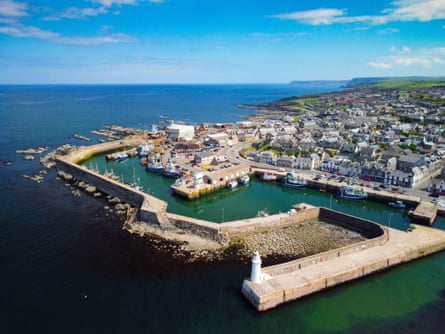
A great day out for marine life enthusiasts, the town of Macduff is home to both a recently refurbished aquarium and High Shore Beach. Like some of the other locations in this list (the Scottish Seabird Centre and Gruinard Bay), High Shore features in one of the Scottish Wildlife Trust’s snorkel trails. Visit the Macduff Marine Aquarium to gen up on the underwater habitats of the Moray Firth and learn what to look out for, then hit the water to explore for yourself. Directly in front of the aquarium is a line of rocky fingers projecting into the sea. These form a series of parallel reefs and a maze of kelp-filled gullies packed with life. As you peer into cracks in the rocks, watch for the red eyes of a velvet swimming crab, or a starfish slowly walking over the reef or seabed – orangey-pink common starfish, knobbly white spiny starfish and common sunstar have all been spotted here.
after newsletter promotion
Gruinard Bay, Wester Ross
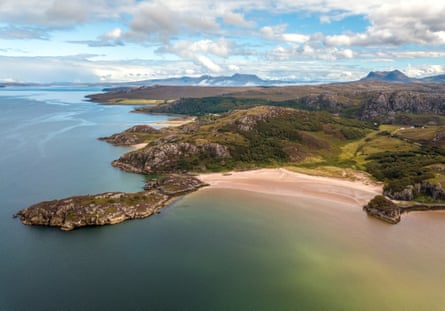
The approach to Gruinard Bay from the south, as the road crests Cadha Beag peak, is spectacular. At the lowest of tides, the beaches at Gruinard are joined, but the incoming waterline soon makes it impossible to move between them without getting wet. The best snorkelling is at the northernmost end of the beach, around a small islet just off the shore. Here, rocky reefs and seagrass meadows exist side by side and provide excellent shelter for various fish and shellfish. Look out for sea slugs and hermit crabs making their way slowly along blades of seagrass, and for flatfish burrowing their way into patches of sand to protect themselves from predators. Watch also for spiky, vivid purple maerl, a hard seaweed that deposits lime in its cell walls as it grows, creating a brittle skeleton. Maerl is very fragile and slow-growing, so take care not to knock into it.
Porth Castell, Ynys Môn (Anglesey)
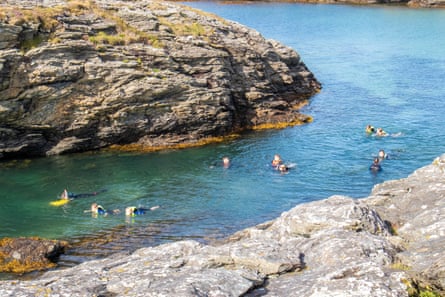
Porth Castell is a small bay that’s sheltered from the open sea by a large offshore island. This fortuitous natural layout provides a wealth of snorkelling opportunities around the rocky reefs that surround the island and run up the bay edges. Arrive at high-ish tide and you can swim through a magnificent narrow gully on the left-hand side of the bay, between the shore and the island. Look into the recesses in the rocks as you go to spot vibrant orange and blue spiny squat lobsters, and more common residents such as crabs and blennies. If you’re very lucky, you might encounter a small-spotted catshark; these are relatively common in British waters but not often glimpsed by snorkellers because they spend relatively little time in the shallows.
Rockham Bay, Devon

A quiet place to be at one with nature and to get away from the well-worn tourist spots of Devon, Rockham Bay is an excellent example of the stratified rock formations that typify this stretch of the north Devon coastline. The unforgiving nature of the sea is apparent here, with the remains of the steamer ship SS Collier strewn over the intertidal rock; wrecked in 1914, there’s not much left to see but the remains of rusted chainworks, a well-weathered winch assembly and other miscellaneous metalworks. Low tide is a good time to explore by land, with the wreckage exposed and the complex rock formations forming tidal pools packed with marine life. Snorkelling around the rocky extremities reveals kelpy reefs: watch out for small spotted catsharks dozing on the sandy seabed as you move from one rocky spur to the next. The nearest car park is at Mortehoe.
How to snorkel safely …
Like open water swimming, snorkelling comes with risks that should be considered when planning your adventure. While experienced swimmers will already be aware of many of the considerations, here are 10 safety tips:
1 Assess your fitness to snorkel before getting in the water
2 Consider undertaking formal snorkelling qualifications
3 Always snorkel with a “buddy”
4 Know how to use your kit and ensure it’s in good condition
5 Assess the site and conditions before entry
6 Regularly monitor your position in the water
7 Use a swim buoy so that boats can easily see you
8 Never swim into underwater structures or caves while snorkelling
9 Get out of the water before you feel cold, and especially before shivering
10 Immediately leave the water if you feel excessively fatigued or short of breath
… and responsibly
Just as important as your own safety is that you don’t cause harm to the eco-systems you’re exploring. Here’s how to snorkel without doing any damage:
1 Follow the Department for Environment, Food and Rural Affairs’s marine and coastal wildlife code
2 Avoid damaging habitats: refrain from stepping on, touching, or holding on to coastal habitats or species
3 Dispose of litter responsibly
4 Use eco-friendly products such as sun cream that’s compatible with the marine environment and, ideally, invest in swimwear that’s been produced by sustainable means
5 Respect marine life, particularly when snorkelling among seals and seahorses, which should not be disturbed
Snorkelling Britain: 100 Marine Adventures by Emma & Gordon Taylor is published by Wild Things Publishing (£18.99). Readers can receive a 20% discount and free postage and packaging with discount code ‘TheGuardian’ at wildthingspublishing.com

 4 hours ago
7
4 hours ago
7


















